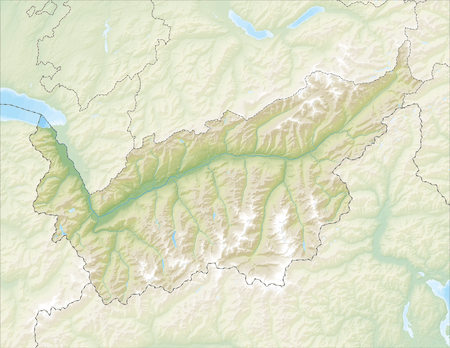Tourbillon Castle
| Tourbillon Castle | |
|---|---|
| Château de Tourbillon | |
| Sion | |
|
Tourbillon Castle | |
 Tourbillon Castle  Tourbillon Castle | |
| Coordinates | 46°14′11″N 7°22′01″E / 46.236455°N 7.366948°E |
| Type | Castle Ruins |
| Site information | |
| Owner | City of Sion |
| Open to the public | yes |
| Site history | |
| Built | 1290-1308 |
| Built by | Boniface de Challant |
| Battles/wars | Raron affair (1417) |
Tourbillon Castle (French: Château de Tourbillon) is a castle in Sion in the canton of Valais in Switzerland. It is situated on a hill and faces the Basilique de Valère, located on the opposite hill. The castle was ruined in a fire in 1788. It is a Swiss heritage site of national significance.[1]
History
The Diocese of Sion was founded in Octodurum, now called Martigny in the early 4th century. In 589 the bishop, St. Heliodorus, transferred the see to Sion, as Octodurum was frequently endangered by the inundations of the Rhone and the Drance. Very little is known about the early Bishops and the early churches in Sion. However, in the late 10th century the last King of Upper Burgundy Rudolph III, granted the County of Valais to Bishop Hugo (998-1017). The combination of spiritual and secular power made the Prince-Bishops the most powerful nobles in the Upper Rhone valley. Sion became the political and religious center of the region. By the 12th century they began building impressive churches and castles in Sion to represent their power and administer their estates.[2] Valère, as the residence of the cathedral chapter in Sion, was one-third of the administrative center of the powerful Diocese of Sion. In the 12th century the Cathedral Notre Dame de Sion (du Glarier) was built in the town below Valère hill.[3] Glarier Cathedral became the seat of the Diocese of Sion, while the Prince-Bishop of Sion lived in the castle.
Tourbillon Castle was built sometime between 1290 and 1308 by the Bishop of Sion, Boniface de Challant, as his principal residence. After Boniface died in 1308, his successor Aymon II de Châtillon probably finished the castle. In 1352 the Upper Valais revolted against Bishop Guichard Tavel. Led by Peter de la Tour, in November of that year, they marched on Sion, burned the town and unsuccessfully besieged the castle.[4] In 1373, the Prince-Bishop bought Majorie Castle and moved his residence off the rocky spire. However, Bishop Tavel was not able to enjoy his new palace for long. In 1375 he was captured and murdered by rebels led by Peter's son, Anton de la Tour, in 1375.[4]
Tourbillon became the Prince-Bishop's summer residence and remained a visible symbol of secular and ecclesiastical power.[5] In 1384 a group of rebels attacked Sion and captured Tourbillon and Majoria. Bishop Eduard of Savoy had to request soldiers from Count Amadeus VII of Savoy and Bern to retake his castles.[4]
A large part of the castle was destroyed during the Raron affair in 1417 and Bishop Wilhelm V of Raron had to flee to Bern. The castle was then rebuilt in the 1440s to 1450s by Bishop Guillaume VI of Raron. As part of the reconstruction, the chapel was repaired and painted with Gothic frescoes which are still visible. It remained the administrative center of the diocese but in later centuries the military importance of the castle decreased. On 24 May 1788, a gigantic fire in Sion reduced the castle to ashes. The Bishop planned to rebuilt Tourbillon, but the revolutions sweeping through Europe ended the plans. The castle was excavated and restored in 1966 to 1969 and again in 1993 to 96.[4]
Castle site
The castle ruins are located on a rocky spire above the city of Sion. Reaching the site requires climbing steep stairs that wind around the hill. The castle is surrounded by a ring wall that follows the irregular top of the spire. On the west side of the complex is a pentagonal fortified building. The 15th century chapel is located in the south-east corner. The chapel's frescoes are still intact despite the fire that destroyed the castle. A slender watch tower still stands in this corner as well. The southern wall is fortified with a square gate house. The keep is rectangular and many of the interior walls still stand.[6]
References
- ↑ "Kantonsliste A-Objekte". KGS Inventar (in German). Federal Office of Civil Protection. 2009. Retrieved 25 April 2011.
- ↑

- ↑ Diocese of Sion - Cathedral (in German) (in French) accessed 19 March 2014
- 1 2 3 4 "Burg Tourbillon". www.burgenwelt.ch. Retrieved 6 July 2017.
- ↑ My Switzerland.com - Tourbillon accessed 19 March 2014
- ↑ "Schloss Tourbillon". www.swisscastles.ch. Retrieved 6 July 2017.
External links
